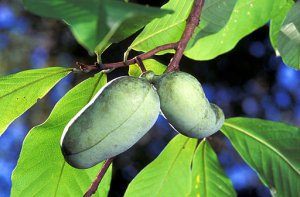Pickled Pawpaws

Pawpaw fruits are fruits from the pawpaw tree (Asimina triloba). The Pawpaw tree is a very unique U.S. native fruit tree. It is very unique because all of its closest relatives are tropical fruit tree species. This tree has evolved to handle cold weather and has brought its tropical flavor with it. Pickled pawpaws are one way to preserve these unique fruits. Pawpaw fruits do not last long under normal conditions, no doubt that this method was used to help preserve these fruits and extend their season of use. Pickled pawpaws use the unripe fruits in a base of mainly vinegar. To read more about the Pawpaw tree see our article Pawpaw Fruits, A Tropical Fruit in Temperate Climates
To be honest the jury is still out on weather eating pickled pawpaws is a good idea since consuming the unripe fruits often makes people a little sick to the stomach. It is possible that if pickled correctly the irritating components of unripe pawpaws could be broken down into less irritating components, but that is just a theory. There are not enough first hand experiences of people eating pickled pawpaws to confirm this so if you have eaten pickled pawpaws please comment below and let us know about your experience.
The Recipe for Green Pickled Pawpaws
Makes 1 pint
Ingredients
1 cup white wine vinegar
¾ cup sugar
½ cup water
½ tsp. ground cinnamon
½ tsp. ground cloves
1 tsp. ground ginger
1 tsp. black peppercorns
1 tbsp. of lime juice
2-3 green pawpaws (cut in half, skinned and seeds removed)
Supplies
1 Pint canning jars , half pint canning jars or quarter pint canning jars
Instructions – no hot water bath
Combine all ingredients except for pawpaws and bring to a boil. Put pawpaws in a pint jar then pour the hot liquid into the jar on top of them. Put the lid on the jar, let it cool then refrigerate. If you do not process the jars in a hot water bath then keep it refrigerated, it should still last a few weeks.
Instructions – process in hot water bath
Combine all ingredients except for pawpaws and bring to a boil. Put pawpaws in a pint jar then pour the hot liquid into the jar on top of them. Put the lid on the jar snug but not too tight. To process jars for canning put them in a large steamer pot of boiling water for 5 mins, the water should be covering the jars. Then take them out, tighten the lids and let cool. Pawpaws processed in a hot water bath should last at least 6 months. They may be less firm then the unprocessed method.
If you try this recipe out please comment below.
Many of our readers find that subscribing to Eat The Planet is the best way to make sure they don't miss any of our valuable information about wild edibles.
See our privacy policy for more information about ads on this site






